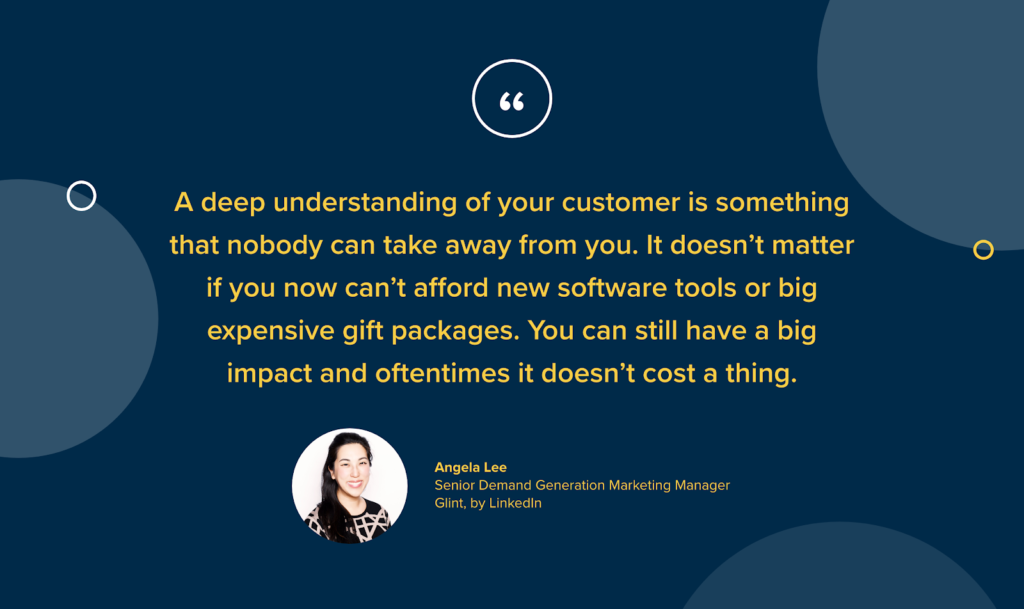ABM Now Issue #1
Agility Never Goes Out of Style
Glint and LeanData on rolling with the punches and why the best tactic—knowing your buyer—is timeless and practically free
 This article is part of the ABM Now series where we explore how ABM has changed in 2020. What will you take with you? What will you leave behind? Read the entire series here.
This article is part of the ABM Now series where we explore how ABM has changed in 2020. What will you take with you? What will you leave behind? Read the entire series here.
One of the first things they teach you in martial arts is how to fall. I find this marvelously humbling—it’s like “Hey we know you’re going to be on your backside a lot. Better learn how to not get hurt.” And I wonder, what if we treated marketing like that?
What if your early days were all about how to respond to a massive, missent email campaign? Or to a sales leader who didn’t like your messaging? Or to a snap recession? I imagine many more of us would have been as prepared for this year as the marketing teams at Glint and LeanData were.
Amidst all the chaos, uncertainty, and pivoting, these two teams found that all the safety rolls and back falls they’d done in years prior helped them land gracefully. And, like a Jiu-Jitsu master, channel that momentum to keep moving.
In this issue, I share three takeaways from my conversation with Angela Lee, Senior Demand Generation Marketing Manager at Glint, and Emily Kono, Field Marketing Manager at LeanData.
Takeaway #1: Never put so many chips on one channel that you can’t walk away tomorrow
Angela Lee
Come January 2020, the team and I at Glint were feeling very confident. It was halfway through our fiscal year. We had already completed one round of account-based marketing focusing heavily on direct mail and of course the LinkedIn platform. We were looking forward to the next round and going even deeper on our personas—HR leaders. Then, Covid-19 hit.
We made a quick messaging switch from “employee engagement” to “navigating troubled times.” It’s the same message, but with a Covid lens. We sell to HR teams and we’re always helping people know what’s going on with their employees. We were still asking, “How do you know what your employees are feeling? What tools can you utilize? What questions should you be asking?” Those questions had just taken on new meaning.
I’d like to give a big shout-out to our content team—they executed on that pivot immediately and developed content pillars that help us all work through this as a global community. Those pillars are “Respond, recover, reimagine.” We looked at all the assets and ads we were running on LinkedIn, we looked at the verbiage and the graphics and asked, “Is this tone-deaf in the world today?” Because we hadn’t overcommitted to any one type of imagery, we could swap pictures of unmasked people for individuals at home juggling pets and kids. I’m actually surprised how quickly we pivoted.
Emily Kono
At LeanData, we had just made a big pivot to a territory sales model in January. We did it because previously, we were solely target account focused, but we wanted the efficiency of reps traveling to their territories and scheduling several meetings. In the same vein, we launched a field marketing role and we were prepared to do events and roadshows and then, yeah. Change. Now it’s a mix of both and everyone’s taken on new duties.
Takeaway #2: People don’t change. Situations do. Keep your strategy. Adjust your messaging.
Angela
Did our audience change? Not really. Not long after the shock, they were interested in what was next. People were wanting to hear more about work-from-home for the long haul and we adapted our content accordingly. We run monthly insight reports where we survey our audience about how they’re feeling and that’s been the sentiment.
Emily
I’d say people are looking for more specific, tactical advice right now. We offer a revenue operations platform and our webinars have sometimes tended to be more macro-level but I think given the extra time people have right now, getting into the nitty-gritty has increased our engagement. For instance, how do you support different go-to-market strategies? Or how do you align your sales team at a tactical level with your tech stack?
Angela
Agreed. People want more tactical advice on how to get through this time and life going forward. Webinars are working well for us too. I think there’s an opportunity in the final months of the year to turn those into truly personalized virtual events. We’re starting to experiment with programs where people can go around the virtual room and share their experiences to recreate that sort of organic relationship-building that you get in-person. It’ll be interesting to see what people can do in the coming year.
Takeaway #3: The best things in life are free
Angela
My advice is that knowing your buyer helps you be agile. We had this whole grand strategy laid out and then all of a sudden we were renegotiating contracts with event vendors and talking about virtual roadshows. But what didn’t change is the fact that we practice ABM. That means we know what makes our buyer tick—we understand their pain points and can anticipate how they’ll evolve.
A deep understanding of your customer is something that nobody can take away from you. It doesn’t matter if you now can’t afford new software tools or big expensive gift packages. You can still have a big impact and oftentimes it doesn’t cost a thing.
Emily
I’d say be open to experimentation. I think ABM is even more important in this new environment because you really do have to get back to the basics at every aspect of your company. Something that has essentially saved LeanData over the past few months is having LeanData as a product. Being able to trust our revenue data has allowed us to be flexible but still steer.
Every budget-conscious marketer in B2B can be using their own stuff. Plus, use this moment to get back to basics. Be sure that your foundational data layer is clean and accurate. I think that has allowed me to align with my sales team amidst all the craziness and execute. That also doesn’t cost a thing.

Given everything you’ve learned this year, what would you leave behind?
Angela
I’d trim more operational fat and leave behind getting caught up thinking in terms of channels. Marketers get caught up with sets—their channels sets, their vendor sets, their event sets. People just continue doing what they’ve always done. But Covid-19 and our new messaging has forced us to peer into every channel and ask, “Are we getting enough out of this?”
Emily
Mine’s similar. I’ll leave behind robotic marketing. When you aren’t challenged, you get stuck in the ‘business as usual’ groove. When it works, you double down. But even if it only half works, you also just keep doing it. You have to shake things up and catch yourself when you’re becoming robotic.
What would you take with you?
Angela
This newfound agility we didn’t know we had. I think we exemplified this as a team, working cross-functionally under duress. We’ll continue to do even more integrated campaigns with the help of LeanData—we recently started doing round robins with our inbound team, and without LeanData we wouldn’t have gotten that figured. You need the data to be correct if you’re going to be agile, and with LeanData, we don’t run into that friction of someone stepping into an account an AE is already working and disrupting them. All those hours they’ve given back to our SDR team has allowed us to continue scaling at the pace that we are.
Emily
Similarly, I would take our strategic and operational agility. If you have a solid understanding of your customer, the correct data, and the foundational processes and technology in place, you can accomplish a lot no matter what comes your way.

Christine Farrier
Sr. Director, Partner and Channel Marketing, Demandbase
Christine Farrier is the Senior Director of Partner Marketing at Demandbase. In this role, she brings together substantive marketing, communications and entrepreneurial expertise primarily focused in the investment banking and technology industries. Prior to joining Demandbase, Christine held marketing leadership roles with IHS Markit and Imagine Software and successfully exited from her arts and culture startup.

Emily Kono
Field Marketing Manager, LeanData
Emily does Field Marketing at LeanData, the leader in go-to-market ops solutions. At LeanData, she executes targeted account-based and field marketing programs to drive revenue within top prospective clients. Outside of marketing, Emily is passionate about revenue team alignment and diversity and belonging in tech. She studied Marketing at Santa Clara University and is based in Los Angeles.

Angela Lee
Senior Demand Generation Marketing Manager, Glint, by LinkedIn
Angela is a current Senior Demand Generation Marketing Manager at Linkedin, where she focuses on Account Based Marketing and Digital Marketing. She has more than 8+ years of marketing experience and has previously held roles at Jobvite, Synopsys and other B2B tech companies. Angela has her Master’s in International Business from the University of California, San Diego and is based out of the Bay Area.